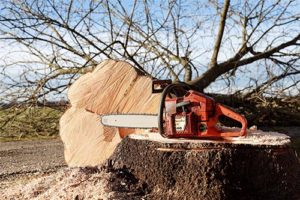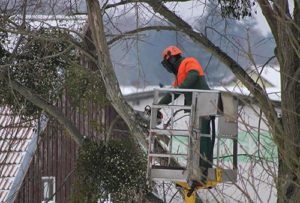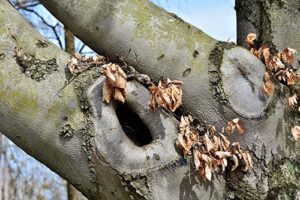Trees are valuable components of our ecosystems, not to mention the cooling and other benefits they can provide around our homes. But sometimes you may need to cut one down. From a wildlife perspective, the best time to cut down a tree is in the winter. All else being equal, I prefer removing trees in the early to mid-winter, rather than later in the winter.

What Are Some of the Reasons to Cut Down a Tree?
There are many reasons why you might choose to remove a tree from your property. Some common reasons include:
- It is a hazard tree which poses a safety risk to people or personal property. If it is a safety risk, it doesn’t matter what time of the year it is. The tree should be removed to make the area safe.
- The tree isn’t a safety risk – yet, but you can tell that it is going to be and you’d rather take care of the problem before it becomes critical. Whether you can wait until winter will depend on the circumstances.
- You want to manage your property for a prairie / grassland habitat, a savanna habitat, or an open woodlands habitat. Prior to European settlement, much of the eastern U.S. was a complex matrix of habitats ranging from open prairie / grasslands to closed canopy forest. Today, grasslands and shrublands are some of our most rapidly disappearing habitats as they are developed or allowed to grow up into forests.
- You want to do a timber harvest.

Why Is Winter the Best Time to Remove Trees?
During the spring and summer, trees may be used as maternity or nesting sites. We all know that many birds nest in trees. Many of our bats also form maternity colonies in tree cavities or under loose bark. Baby birds and baby bats can’t fly. Cutting down a tree in the spring or summer risks killing any baby birds or baby bats in the tree.
In the winter, we don’t have any nesting birds or bat maternity colonies to worry about. Few, if any, of our bats hibernate in trees so you aren’t likely to disturb any bats by cutting down a tree during the winter. Birds may roost among the tree’s branches or in small cavities, but those are transient roosts. Winter birds can, and often do, move from one place to the next. So, if a winter roost disappears, the birds will just move to another. However, many of our owls and some of our hawks will begin nesting in late winter or very early spring, which is why I prefer to remove trees in early to mid-winter, if possible.

Summary
There are many reasons why you might need to cut down a tree. Those reasons will vary from person to person and may include safety, economic, and habitat management considerations, just to name a few. Cutting trees in winter, especially the early to mid-winter, will typically have the fewest negative impacts on your local wildlife.

Backyard Ecology: Exploring Nature in Your Backyard
Nature isn’t just “out there.” It’s all around us, including right outside our doors. Hi, my name is Shannon Trimboli, and I am the host of Backyard Ecology. I live in southcentral Kentucky and am a wildlife biologist, educator, author, beekeeper, and owner of a nursery specializing in plants for pollinators and wildlife conservation. I invite you to join me as we ignite our curiosity and natural wonder, explore our yards and communities, and improve our local pollinator and wildlife habitat. Learn more or subscribe to my email list at www.backyardecology.net.

Leave a Reply